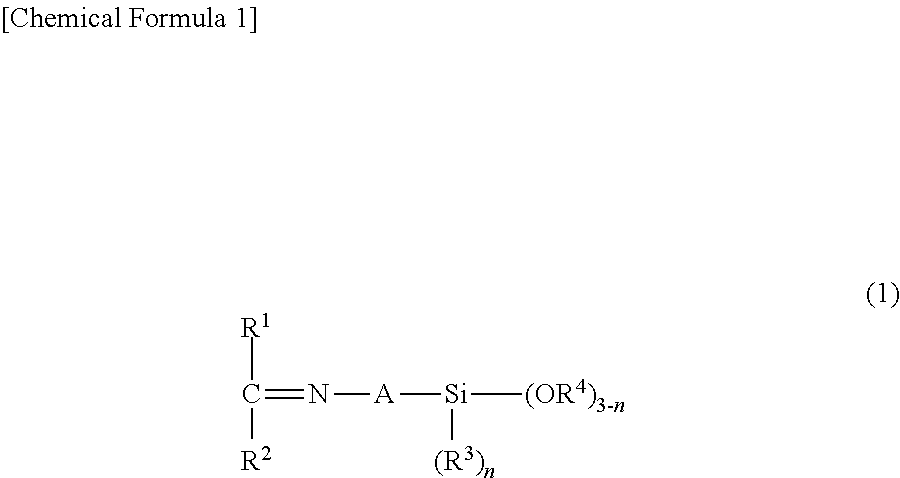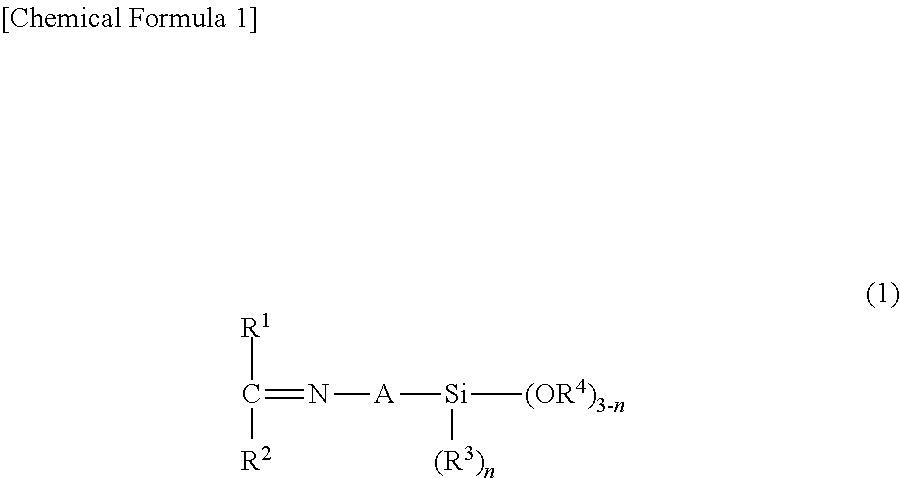Urethane-type curable organic binder for mold, and molding sand composition and mold obtained using the same
a technology of organic binder and mold, which is applied in the direction of manufacturing tools, foundry cores, and mold molds, which can solve the problems of production troubles due to the pot life of molding sand composition, mold strength significantly lower mold strength significantly less than the desired mold strength, etc., to achieve the effect of reducing mold strength, increasing catalyst requirements, and prolonging pot li
- Summary
- Abstract
- Description
- Claims
- Application Information
AI Technical Summary
Benefits of technology
Problems solved by technology
Method used
Image
Examples
example 1
[0058]First, 0.2 part by mass of N-(1,3-dimethylbutylidene)-3-(triethoxysilyl)-1-propanamine was added to 100 parts by mass of the phenolic resin solution A, and dissolved therein by stirring. Then, a Shinagawa-shiki desktop mixer (manufactured by Dalton Co., Ltd.) was charged with: 1000 parts by mass of a flattery silica sand which had been left in an atmosphere of a temperature of 30° C. and a relative humidity of 60%, for 24 hours; 10 parts by mass of the phenolic resin solution A containing N-(1,3-dimethylbutylidene)-3-(triethoxysilyl)-1-propanamine; and 10 parts by mass of the polyisocyanate solution prepared as described above. The contents in the mixer were stirred and kneaded for 40 seconds, to prepare a molding sand coated with an organic binder, namely, a molding sand composition.
[0059]Then, with respect to the thus prepared molding sand composition, the mold strength was measured according to the above-described test method, by using the molding sand composition having no...
examples 2 to 4
[0060]Molding sand compositions according to the respective Examples were prepared like the Example 1, by the same manner described above with respect to the preparation of the molding sand composition of the Example 1, except that N-(1,3-dimethylbutylidene)-3-(triethoxysilyl)-1-propanamine was added in respective amounts shown in Table 1 given below. Then, with respect to the thus prepared molding sand compositions, the mold strength was measured according to the above-described test method, by using the molding sand compositions having no waiting time after the kneading (used immediately after the kneading) and the molding sand compositions having a waiting time of 2 hours or 4 hours. The results of the measurement are shown in Table 1 given below.
examples 5 to 8
[0061]Molding sand compositions according to the respective Examples were prepared like the Examples 1 to 4, by the same manner described above with respect to the preparation of the molding sand composition of the Example 1, except that N-(1,3-dimethylbutylidene)-3-(trimethoxysilyl)-1-propanamine was used in place of N-(1,3-dimethylbutylidene)-3-(triethoxysilyl)-1-propanamine. Then, with respect to the thus prepared molding sand compositions, the mold strength was measured according to the above-described test method, by using the molding sand compositions having no waiting time after the kneading (used immediately after the kneading) and the molding sand compositions having a waiting time of 2 hours or 4 hours. The results of the measurement are shown in Table 1 given below.
PUM
| Property | Measurement | Unit |
|---|---|---|
| temperature | aaaaa | aaaaa |
| thickness | aaaaa | aaaaa |
| length | aaaaa | aaaaa |
Abstract
Description
Claims
Application Information
 Login to View More
Login to View More - R&D
- Intellectual Property
- Life Sciences
- Materials
- Tech Scout
- Unparalleled Data Quality
- Higher Quality Content
- 60% Fewer Hallucinations
Browse by: Latest US Patents, China's latest patents, Technical Efficacy Thesaurus, Application Domain, Technology Topic, Popular Technical Reports.
© 2025 PatSnap. All rights reserved.Legal|Privacy policy|Modern Slavery Act Transparency Statement|Sitemap|About US| Contact US: help@patsnap.com



